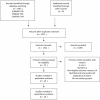Statins for the prevention of stroke: a meta-analysis of randomized controlled trials
- PMID: 24643199
- PMCID: PMC3958535
- DOI: 10.1371/journal.pone.0092388
Statins for the prevention of stroke: a meta-analysis of randomized controlled trials
Abstract
Background: Stroke is a frequently encountered clinical event that has a detrimental impact on the quality of life. Evidence has increasingly shown that statins can substantially reduce the risk of coronary heart disease. However, it remains to be determined whether statins are definitively effective in preventing stroke.
Methods: We systematically searched the PubMed, Embase, and Central databases for studies that compared the effects of statins and placebo in patients at high risk for stroke. The outcome measures were overall incidence of stroke, incidence of fatal stroke, and incidence of hemorrhagic stroke.
Results: Eighteen randomized controlled trials satisfied all the inclusion criteria for the meta-analysis. The analysis revealed that statins reduced the overall incidence of stroke than placebo (odds ratio [OR]: 0.80; 95% confidence interval [CI]: 0.74-0.87; P<0.00001). In particular, statins showed efficacy in reducing the incidence of fatal stroke (OR: 0.90; 95% CI: 0.67-1.21; P = 0.47) and hemorrhagic stroke (OR: 0.87; 95% CI: 0.60-1.25; P = 0.45). On the contrary, they were found to increase the overall incidence of stroke (OR: 1.12; 95% CI: 0.89-1.41; P = 0.32) and fatal stroke (OR: 1.37; 95% CI: 0.93-2.03; P = 0.11) in renal transplant recipients and patients undergoing regular hemodialysis.
Conclusion: The results of this analysis suggest that statins may be beneficial in reducing the overall incidence of stroke and they may decrease the risk of fatal stroke and hemorrhagic stroke. However, statins should be used with caution in patients with a history of renal transplantation, regular hemodialysis, transient ischemic attack, or stroke. Further analyses should focus on multicentre, double-blind, placebo-controlled randomized trials with data stratification according to the nature of primary diseases and dose-effect relationship, to clarify the benefits of statins in protection against stroke.
Conflict of interest statement
Figures







References
-
- Mohr JP, Albers GW, Amarenco P, Babikian VL, Biller J, et al. (1997) American Heart Association Prevention Conference. IV. Prevention and Rehabilitation of Stroke. Etiology of stroke. Stroke 28: 1501–1506. - PubMed
-
- Kent DM (2006) Stroke—an equal opportunity for the initiation of statin therapy. N Engl J Med 355: 613–615. - PubMed
-
- Robinson JG, Smith B, Maheshwari N, Schrott H (2005) Pleiotropic effects of statins: benefit beyond cholesterol reduction? A meta-regression analysis. J Am Coll Cardiol 46: 1855–1862. - PubMed
-
- Calabro P, Yeh ET (2005) The pleiotropic effects of statins. Curr Opin Cardiol 20: 541–546. - PubMed
-
- Chen J, Zhang ZG, Li Y, Wang Y, Wang L, et al. (2003) Statins induce angiogenesis, neurogenesis, and synaptogenesis after stroke. Ann Neurol 53: 743–751. - PubMed
Publication types
MeSH terms
Substances
LinkOut - more resources
Full Text Sources
Other Literature Sources
Medical

